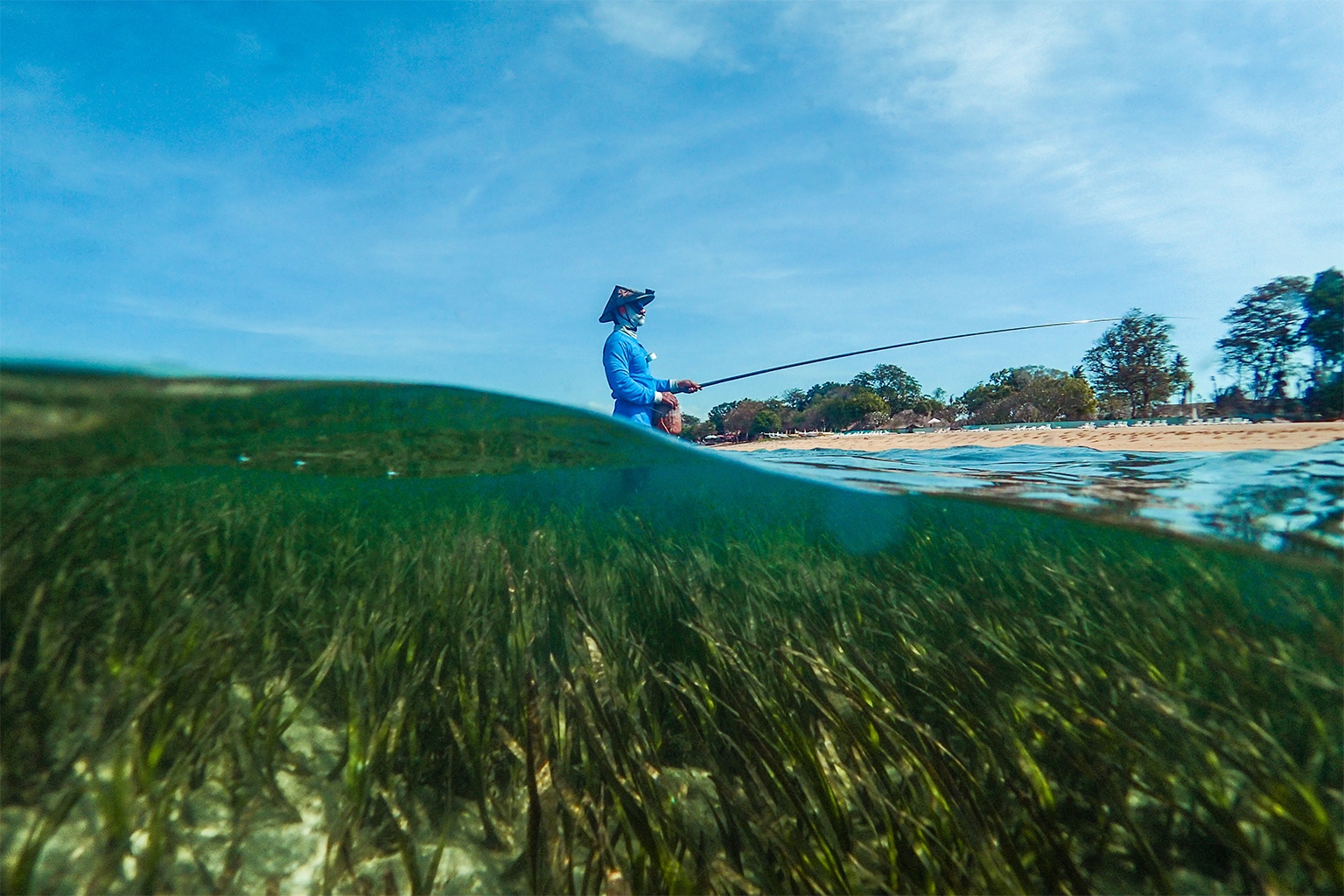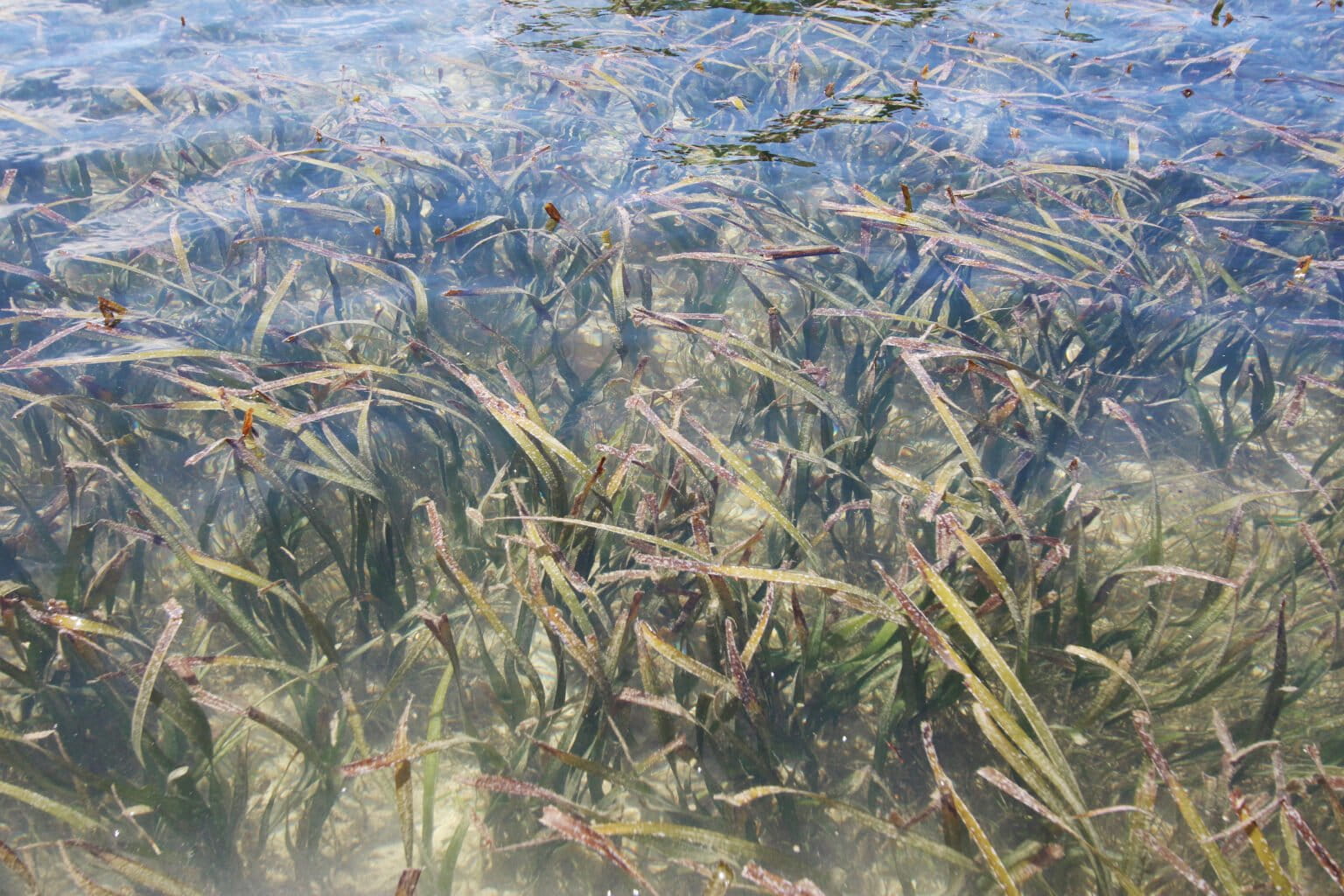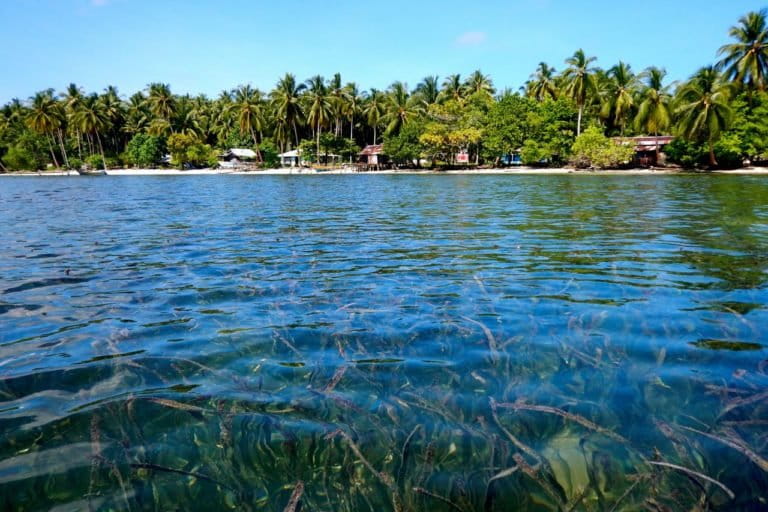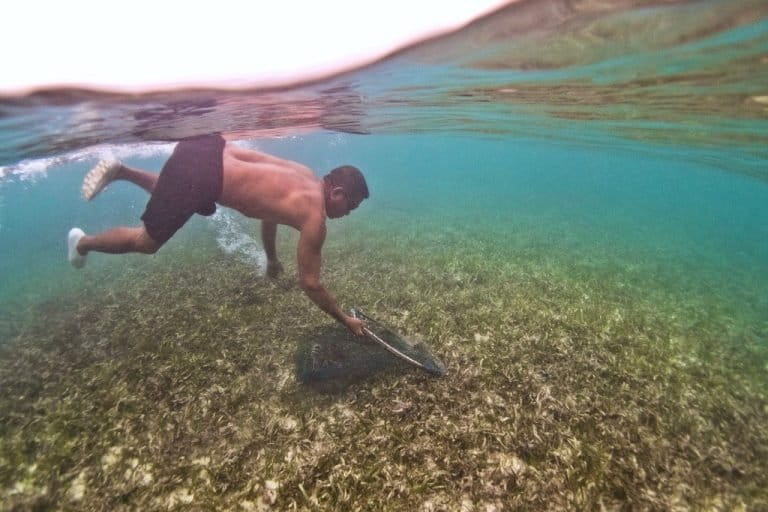Indonesia is moving to designate 17 seagrass habitats as national strategic areas for blue carbon, a plan that promises climate and community benefits but raises concerns over safeguards.

Healthy seagrasses are an important home for marine life, including an estimated one-quarter of the world’s 25 largest fisheries. Image by Benjamin Jones/Project Seagrass.
Indonesia’s push to legalize a blue carbon zoning plan that’s focused on seagrass has sparked optimism for climate solutions, but some experts debate its risks and safeguards.
The Indonesian Marine Affairs and Fisheries Ministry has been drafting new amendments to a 2019 government regulation to designate 17 seagrass habitats across the archipelago as certain “national strategic areas” (KSNT), giving them priority status for sovereignty, environmental protection and global heritage. The ministry’s director-general of marine spatial management, Kartika Listriana, said the zoning plan for Blue Carbon Reserves was a pledge to fight the climate crisis, protect ocean ecosystems and support coastal communities.
“Marine spatial planning is meant to create real benefits,” she said in a Sept. 14 press release, “from giving investors legal certainty in the marine and fisheries sectors to improving community welfare to safeguarding our coasts and seas.”

Indonesia is moving to designate 17 seagrass habitats as national strategic areas for blue carbon, a plan that promises climate and community benefits but raises concerns over safeguards. Image courtesy of Eko Siswono Toyudho/Konservasi Indonesia.
Indonesia holds about 11.5% of the world’s seagrass meadows, a resource the government hopes to tap to expand its carbon storage capacity. Scientists estimate that, per unit area, seagrass can capture carbon up to 35 times more effectively than tropical rainforests.
According to the ministry, 17 sites have been earmarked as indicative KSNT locations for blue carbon reserves under the 2025-45 National Spatial Plan. The proposed zones stretch from Kotabaru to the Derawan and Tanimbar islands and Aru Islands to coastal areas around Bombana, Pohuwato, Kwandang, Lingga, Menui, Bontang, Sapudi and Kangean, Tual, Nias, Subi, Toli-Toli and Supiori.
Kartika said the economic potential in the carbon market was significant, with carbon valuation reaching $800,000 per square kilometer (0.4 square miles) of seagrass beds. She added that several requirements were needed to support seagrass in the carbon market, including regulations to incorporate blue carbon, implementation of impact-reduction management for land and marine activities to improve seagrass ecosystem health and stakeholder involvement in seagrass management.
In its updated Paris Agreement climate pledge, Indonesia has set an emissions-cut target of 31.8% from business-as-usual levels, or 43.2% with international support, with land use and forestry seen as the biggest opportunities. But the ocean may hold equally untapped potential, like in seagrasses. These underwater plants — distinct from seaweed — thrive in shallow coastal waters, serving as vital nurseries for young fish. Globally, though, they’re disappearing at about 7% each year, a loss on par with the decline of coral reefs and tropical rainforests, according to the IUCN.
Konservasi Indonesia has been working with the fisheries ministry since May to help profile the locations for seagrass zoning, said Susan Lusiana, the environmental foundation’s senior manager for blue carbon. She called the plan to designate seagrass habitats as KSNT a major step for ocean protection and climate action but cautioned that zoning must be more than words on paper; it has to be enforceable and workable in practice.
“We’re helping gather relevant data — biophysical, hydrological, carbon and socioeconomic. Each site will then have a profile and potential financing options tailored to its context,” she said.
Indonesia’s seagrass meadows cover an estimated 800,000 hectares (about 2 million acres), according to an official presentation document by the fisheries ministry shared with Mongabay. Nearly a third of that, about 250,000 hectares (618,000 acres), has been earmarked for protection under the KSNT regulation. The ministry said these zones were estimated to store more than 30 million tons of carbon and lock away the equivalent of more than 6 million tons of CO2.
The document also described criteria for the sites to qualify for KSNT designation; namely, they must represent significant seagrass or mangrove coverage (at least 2,700 hectares or 6,670 acres), hold medium to high carbon stocks with minimal human pressure and reflect both local priorities and scientific backing. Susan pointed out that transparent and scientific criteria are needed to decide which seagrass habitats qualify as KSNT, so that the designation is ecologically sound and not influenced by political or economic interests.
“I remain optimistic KSNT can become a strong collaboration platform, though challenges exist,” she told Mongabay in a recent interview. “Blue carbon [management] spans six directorates and two directorates-general within KKP, so responsibilities and authority must be clearly divided.”

The inhabitants of Auki island in Indonesia’s Papua province have for generations depended on the rich resources from coastal ecosystems, such as seagrass, mangroves and marine life. Image by Ridzki R. Sigit/Mongabay Indonesia.
Wiro Wirandi, founder of the NGO Konservasi Laboratorium, said his group has been monitoring the government’s push to legalize blue carbon zoning under the KSNT framework, particularly through regulations tied to the economic value of carbon.
“From the framework we’ve seen, this is conservation that will be commercialized, so seagrass areas will be maintained and then their carbon sold,” Wiro told Mongabay in an interview.
On the selection of 17 indicative locations, Wiro pointed out that most were chosen for their rich seagrass and mangrove cover as well as their familiarity with past conservation projects that make them easier to manage. He added that success would depend not only on ecological potential but also on social acceptance by local communities.
“If communities reject them, investors will not be interested,” he said.
Indonesia has long been considered one of the world’s most important strongholds for seagrass. In 1994, researchers estimated the country’s seagrass meadows spanned around 30,000 km2 (11,600 mi2), likely the largest of any nation. But by June 2017, the Indonesian Institute of Sciences reported that only 1,507 km2 (582 mi2) remained—a staggering decline.
Scientists point to climate change, pollution, coastal development and invasive species as key drivers of this loss. Globally, more than 70 species of seagrass are found, together covering about 600,000 km2 (232,000 mi2) — an area larger than Madagascar.
Karenina Lasrindy, the program manager for blue carbon ecosystem management at Indonesia Ocean Justice Initiative, said KSNT zoning for seagrass meadows must be grounded in a strong legal basis and transparent governance. She highlighted that the biggest risk lies in the potential privatization of marine spaces under the guise of carbon markets, which could restrict small-scale fishers’ access to traditional fishing grounds and undermine community livelihoods.
“I heard there is potential for this to be directed into RBP, and if that’s the case, our hope is that coastal communities will become the main beneficiaries,” Karenina told Mongabay in an interview, referring to the result-based payment mechanism.
Karenina stressed the importance of free, prior and informed consent for coastal and Indigenous communities, noting that without meaningful participation, the policy could replicate past conflicts seen in marine protected areas where promised benefits never reached local residents. She said the so-called national strategic projects (PSN) pose one of the greatest threats to blue carbon ecosystems, particularly seagrass meadows that are easily damaged. Under current rules, Karenina noted, PSN-designated developments can override conservation areas, forest protection zones and even marine protected areas, with Government Regulation No. 21/2021 allowing such projects in core zones.
“The hope is that once KSNTs are designated under a presidential regulation, PSN projects cannot override them, since both would have the same legal level,” she said.
She also called for clear benefit-sharing mechanisms and open monitoring systems to ensure accountability, warning that the carbon business is vulnerable to elite capture and exploitation unless safeguards are enforced.
Karenina urged policymakers to balance conservation with social justice, arguing that blue carbon initiatives should not only secure Indonesia’s climate commitments but also directly improve the welfare of coastal communities that have long acted as the first stewards of seagrass ecosystems.
“More studies are needed, but empowering local groups is key,” she said. “Empowering fishers to protect seagrass is also part of this.”
Konservasi Indonesia’s Susan said that relying solely on carbon trading would be risky and insufficient, suggesting that a mix of financing sources between state budget allocation, grants and blended funding should be developed to support sustainable management. She added that local communities must be involved in both planning and implementation, as they are the most affected stakeholders and key to ensuring long-term success of blue carbon initiatives.
“The government is right to recognize blue carbon’s potential and include it in the NDC, but sometimes it’s misunderstood as just ‘let’s sell it,’” she said. “In reality, carbon trading only makes sense case by case, mainly in degraded areas. Healthy seagrass should focus on conservation, financed by other mechanisms.”

A fisherman collects sea urchins in shallow seagrass meadows in Indonesia. Image by Benjamin Jones/Project Seagrass.
Author: Basten Gokkon
This article was originally published on Mongabay under the Creative Commons BY NC ND licence. Read the original article.
.jpg)



